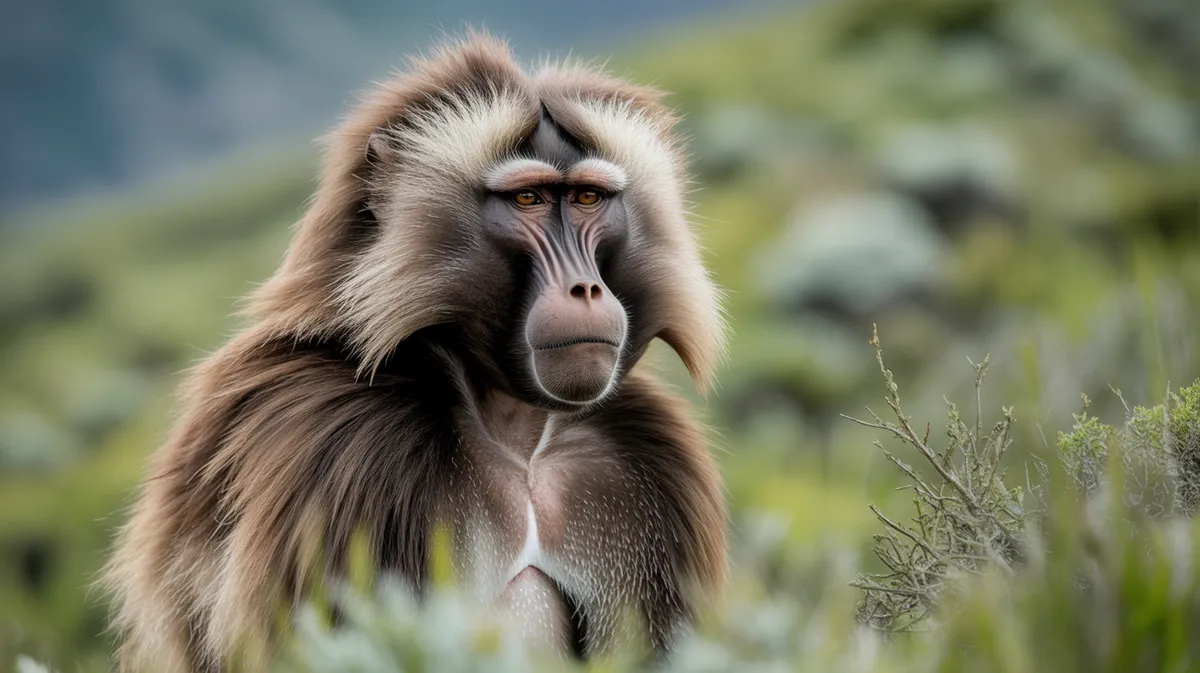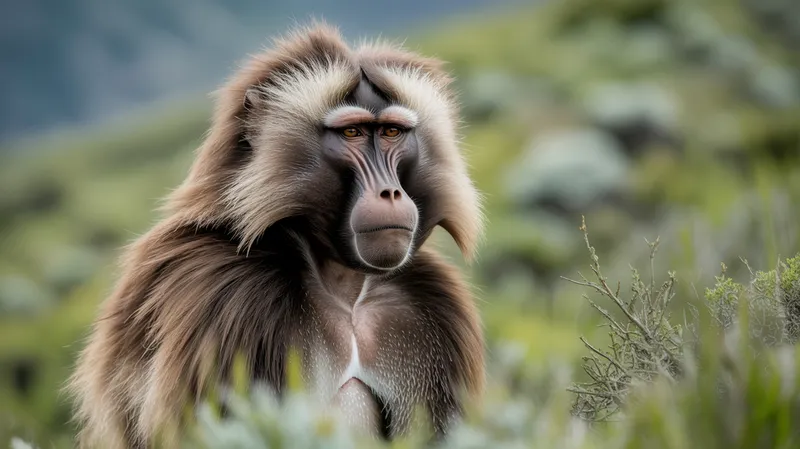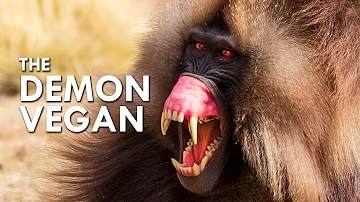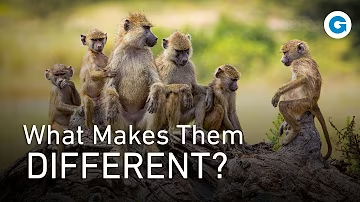
Gelada Baboon
Theropithecus gelada

Meet the Gelada Baboon
The Gelada is a unique Old World monkey found exclusively in the Ethiopian Highlands. Distinguished by its hourglass-shaped red patch of skin on the chest, the Gelada is often called the 'bleeding-heart monkey.' It spends most of its life on the ground, grazing on grasses and herbs, which is unusual for primates. Geladas are highly social, living in large, complex groups that can number in the hundreds, and communicate through a rich array of vocalizations and facial expressions.
Classification
Mammal
Habitat
Mountain grasslands
Diet
Herbivore
Lifespan
15-20 years
Conservation
Least Concern
Weight
11-19 kg
📖Fascinating Facts
Grass Diet
Geladas are the world's only grazing primate, with over 90% of their diet consisting of grass.
Unique Chest Patch
Mature geladas have a distinctive red hourglass-shaped patch of bare skin on their chest, which intensifies in color during mating season.
Highland Dwellers
Geladas are found only in the high-altitude grasslands of the Ethiopian Plateau, often at elevations between 1,800 and 4,400 meters.
📋Detailed Description
The gelada (Theropithecus gelada) is a large, robust Old World monkey endemic to the Ethiopian Highlands, particularly the grassland plateaus at elevations of 1,800–4,400 meters. Adult males are striking, weighing 18–21 kg and measuring up to 74 cm in body length, with a long, flowing mane and a distinctive hourglass-shaped bare patch of red skin on the chest, which intensifies in color during mating periods. Females are smaller, averaging 11–14 kg, and exhibit a necklace of bead-like vesicles around the chest patch. Geladas possess a unique set of adaptations for their graminivorous lifestyle, including highly dexterous hands with short fingers and opposable thumbs, allowing them to pluck individual grass blades efficiently. Their dentition features large incisors for cropping grass and robust molars for grinding. Socially, geladas form one of the most complex multi-level societies among primates, with basic reproductive units (one-male units or OMUs) aggregating into bands, herds, and occasionally massive communities of up to 1,200 individuals. Vocal communication is exceptionally rich, with over 30 distinct calls and complex facial expressions, supporting their intricate social structure. Geladas are diurnal, spending most of the day foraging and socializing on open grasslands, and retreating to steep cliffs at night for safety. Their lifespan in the wild is estimated at 15–20 years, with some individuals reaching over 30 years in captivity.
💡 Did you know?
Despite their baboon-like appearance, geladas are the only surviving member of their genus, Theropithecus, and are more closely related to baboons than to any other living monkey.
🔬Research & Sources
Wikipedia Summary
The gelada, sometimes called the bleeding-heart monkey or the gelada baboon, is a species of Old World monkey found only in the Ethiopian Highlands, living at elevations of 1,800–4,400 m (5,900–14,400 ft) above sea level. It is the only living member of the genus Theropithecus, a name derived from the Greek root words for "beast-ape". Like its close relatives in genus Papio, the baboons, it is largely terrestrial, spending much of its time foraging in grasslands, with grasses comprising up to 90% of its diet.
Last Modified: 5/25/2025
🎭Behavior & Social Structure
Geladas are primarily terrestrial and spend up to 70% of their waking hours feeding, making them the most graminivorous primate known. Their diet consists of 90% grasses—mainly blades, seeds, and occasionally roots—supplemented by herbs, flowers, and small invertebrates during dry seasons. Foraging occurs in large, loose aggregations, with individuals using their nimble fingers to pick grass blades. Social interactions are frequent and include grooming, play, and elaborate vocal exchanges; grooming serves both hygienic and social bonding functions. Males defend their OMUs from bachelor males through displays and, occasionally, physical confrontations. Daily routines involve descending from sleeping cliffs at dawn, feeding and socializing throughout the day, and returning to cliffs at dusk. Geladas are highly vigilant, with sentinels watching for predators such as leopards, hyenas, and eagles.
👶Reproduction & Life Cycle
Geladas are polygynous, with dominant males maintaining exclusive mating access to the females in their OMU, typically comprising 1–12 females and their offspring. Females exhibit sexual swellings and the chest patch becomes more pronounced during estrus. Breeding is non-seasonal but peaks during the rainy season (June–September). After a gestation period of approximately 175–180 days, females give birth to a single infant, which clings to the mother's belly for the first few months. Weaning occurs around 12–18 months. Infant care is primarily maternal, but allomothering (care by other females) is common. Male tenure in OMUs averages 2–4 years, after which they are often displaced by bachelor males.
🛡️Adaptations & Survival
Geladas are uniquely adapted to high-altitude grassland life. Their thick fur provides insulation against cold mountain temperatures, while their bare chest patch aids in social signaling and possibly thermoregulation. Their highly opposable thumbs and short fingers are specialized for precision grass-plucking, a rare adaptation among primates. The robust jaw and specialized dentition allow efficient processing of tough grasses. Behavioral adaptations include complex social structures for predator detection and resource sharing, and the use of steep cliffs for nocturnal refuge, minimizing predation risk.
📚Research Sources
🎨Cultural Significance
Geladas hold a prominent place in Ethiopian culture, often featured in local folklore and traditional stories as symbols of the highlands. Their dramatic appearance and social behaviors have inspired both reverence and superstition among highland communities. While not commonly hunted for food due to cultural taboos, they are sometimes perceived as crop pests. Geladas are also important for ecotourism in Ethiopia, attracting researchers and wildlife enthusiasts.
🔬Recent Research & Discoveries
Recent research has focused on gelada vocalizations, revealing a degree of vocal complexity and flexibility comparable to that of some apes, making them a model for the study of primate communication evolution. Studies on their multi-level social organization have provided insights into the evolution of complex societies. Ongoing research includes the impact of habitat fragmentation, genetic diversity among isolated populations, and the effects of climate change on their highland ecosystems. Notably, geladas are the only primates known to primarily feed on grass, making them a unique subject for studies on dietary specialization and digestive physiology.
🎥Wildlife Videos

Gelada: This Baboon Cosplays As A Carnivore
Meet the herbivore with teeth like a carnivore, the Gelada. Watch our new documentary 'Strange Creatures of the Arctic' with an ...
Animalogic

Wild Dramas in the Rift Valley - The Baboons of Kenya | Full Documentary
A troop of Anubis baboons lives in the heart of Kenya. Little by little, we get to know the characters in the troop: There's wise ...
Free High-Quality Documentaries

Wildlife Instincts | Mandrills - Battle of the Alphas | Free Documentary Nature
Wildlife Instincts: Mandrills - Battle of the Alphas | Wildlife Documentary Watch 'Wildlife Instincts: Cheetah - The Fastest Animal on ...
Free Documentary - Nature

Gelada Baboons | National Geographic
About National Geographic: National Geographic is the world's premium destination for science, exploration, and adventure.
National Geographic

Defending a Monkey Harem | Clever Monkeys | BBC Earth
Welcome to BBC EARTH! The world is an amazing place full of stories, beauty and natural wonder. Here you'll find 50 years worth ...
BBC Earth

From The Amazon to Africa - The Secret Codes of Monkey Life | Full Wildlife Documentary
Today we tour the globe, spending time with primates of all sizes, like Pygmy Marmosets of the Amazon through to impressive ...
Get.factual
🌍Habitat Information
The Gelada Baboon typically inhabits Mountain grasslands environments. Gelada Baboons have adapted to their environments with specialized features and behaviors.
Primary Habitat:
Mountain grasslands
More detailed habitat information will be available soon.
🛡️Conservation Status
The Gelada Baboon is currently classified as Least Concern. Conservation efforts are crucial for preserving this species for future generations.
Common Threats:
- 🏠Habitat loss and fragmentation
- 🌡️Climate change impacts
- 🎯Hunting and poaching
- 🏭Human-wildlife conflict
⚠️Threats & Conservation Challenges
Although currently listed as Least Concern by the IUCN, geladas face several threats. Habitat loss due to agricultural expansion, overgrazing by livestock, and human settlement encroachment are significant challenges. Fragmentation of populations increases vulnerability to local extinction. Occasional hunting for bushmeat or as crop pests, and potential disease transmission from livestock, also pose risks. Climate change may further impact their highland habitats. Population estimates suggest around 200,000 individuals remain, but some subpopulations are declining.
🔬Scientific Classification
Scientific Name
Theropithecus gelada
Classification Hierarchy
🔍 About Taxonomic Classification
Taxonomic classification is a hierarchical system used by scientists to classify and organize living organisms based on shared characteristics and evolutionary relationships.
The system moves from broad categories (Kingdom) to increasingly specific ones, with each animal's scientific name typically consisting of its Genus and species.
📝Community Notes
Share your observations and insights about the Gelada Baboon with our community of wildlife enthusiasts.
Join Our Community
Sign in to share your observations and connect with fellow wildlife enthusiasts.
Sign In to ContributeNo community notes yet
Be the first to share your observations about the Gelada Baboon!
Explore Gelada Baboon
Select a tab above to learn more about this amazing animal.
📸Photo Gallery
No photos available for this animal yet.
🌟Discover More Wildlife
Continue your journey of discovery with more fascinating animals from our database
